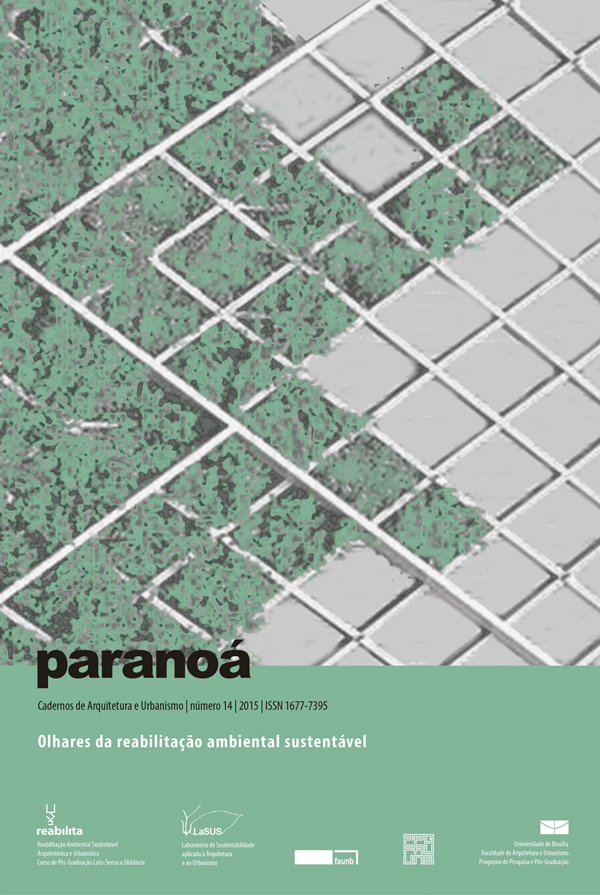The microclimate created by water mirrors: a case study of the reflection pool of the National Congress
DOI:
https://doi.org/10.18830/issn.1679-0944.n14.2015.16927Keywords:
Ecological landscape, Wetland Igarape da Fortaleza, APA da FazendinhaAbstract
This article deals with the case study of the reflective pool of the National Congress, in order to verify, through measurements of the Maximum Air Temperature and Relative Air Humidity, the importance of this aesthetic-architectural element as a facilitator, from the point of view of view of the hygrothermal comfort, the microclimate of the building and its surroundings. Therefore, the main objective is to investigate whether the water surface of the National Congress offers a favorable microclimate in its surroundings compared to the areas adjacent to it, through evaporative cooling. The work was structured as follows: first, the report of architectural elements with water in the historical context and the examples applied in Brasília; Then, an approach to the concept of hygrothermal comfort; Next, description of measurements and methods used; finally, the comparison of the measured data with the data provided by INMET (National Institute of Meteorology). It was concluded that the use of this element is applicable to the reality of Brasília. The increase in Relative Air Humidity verified is approximately 10% and the Maximum Air Temperature, on average, suffered a decrease of 3.7ºC in the environments close to the reflection pool.
Downloads
References
AMORIM, Cláudia Naves D. e BRAGA, Darja Kos. Métodos e técnicas para conforto ambiental e reabilitação do espaço construído, pág. 618 a 684, in Reabilita -Registro de Curso de Especialização à Distância, Romero(org.), Faculdade de Arquitetura e Urbanismo ”“ FAU ”“ UnB, Brasília, 2009.
ASSOCIAÇÃO BRASILEIRA DE NORMAS TÉCNICAS. NBR 15220 ”“ Desempenho Térmico das Edificações, Parte 1: Definições, símbolos e unidades, Rio de Janeiro, 2003.
ASSOCIAÇÃO BRASILEIRA DE NORMAS TÉCNICAS. NBR 15220 - Desempenho Térmico das Edificações, Parte 3: Zoneamento bioclimático brasileiro e diretrizes construtivas para habitações unifamiliares de interesse social, Rio de Janeiro, 2003.
ASSOCIAÇÃO BRASILEIRA DE NORMAS TÉCNICAS.NBR 1050 ”“ Informação e documentação ”“ Citações em documentos ”“ Apresentação, Rio de Janeiro, 2002.
ASSOCIAÇÃO BRASILEIRA DE NORMAS TÉCNICAS. NBR 6023 ”“ Informação e documentação ”“ Referências e elaboração. Rio de Janeiro, 2002.
ASSOCIAÇÃO BRASILEIRA DE NORMAS TÉCNICAS.NBR 6024 ”“ Informação e documentação ”“ Numeração Progressiva das Seções de um documento escrito ”“ Apresentação, Rio de Janeiro, 2003.
ASSOCIAÇÃO BRASILEIRA DE NORMAS TÉCNICAS. NBR 6027 ”“ Informação e documentação ”“ Sumário ”“ Apresentação, Rio de Janeiro, 2003.
ASSOCIAÇÃO BRASILEIRA DE NORMAS TÉCNICAS. NBR 6028 ”“ Informação e documentação ”“ Resumo ”“ Apresentação, Rio de Janeiro, 2003.
ASSOCIAÇÃO BRASILEIRA DE NORMAS TÉCNICAS. NBR 6034 ”“ Informação e documentação ”“ Índices ”“ Apresentação, Rio de Janeiro, 2004.
ASSOCIAÇÃO BRASILEIRA DE NORMAS TÉCNICAS. NBR 14724 ”“ Informação e documentação ”“ Trabalhos Acadêmicos -Apresentação, Rio de Janeiro, 2011.
FAZIO, Michael et al. A História da Arquitetura Mundial. 3ª ed. Porto Alegre: AMGH, 616p. 2011.
FROTA, Anésia Barros e SCHIFFER, Sueli Ramos. Manual de Conforto Térmico - 5ª ed. ”“ São Paulo: Studio Nobel, 2001.
LAMBERTS, R. et al. Eficiência Energética na Arquitetura. São Paulo: PW, 1997.
LAMBERTS, Roberto e XAVIER, Antônio Augusto de Paula. Conforto Térmico e Stress Térmico. Florianópolis, 2002.
ROMERO, Marta Adriana Bustos. Princípios Bioclimáticos para o Desenho Urbano.São Paulo: ProEditores. 123p. 2000.
ROMERO, Marta Adriana Bustos. Estratégias Bioclimáticas de Reabilitação Ambiental Adaptadas ao Projeto, pág 518 a 573, in Reabilita ”“ Registro de Curso de Especialização à Distância, Romero(org.), Faculdade de Arquitetura e Urbanismo ”“ FAU ”“ UnB, Brasília, 2009.
Downloads
Published
How to Cite
Issue
Section
License
Copyright (c) 2015 Paranoá: journal of Architecture and Urbanism

This work is licensed under a Creative Commons Attribution 4.0 International License.
Autores que publicam nesta revista concordam com os seguintes termos:
- Autores mantém os direitos autorais e concedem à revista o direito de primeira publicação, com o trabalho simultaneamente licenciado sob a Licença Creative Commons Attribution que permite o compartilhamento do trabalho com reconhecimento da autoria e publicação inicial nesta revista. http://creativecommons.org/licenses/by/4.0
- Autores têm autorização para assumir contratos adicionais separadamente, para distribuição não-exclusiva da versão do trabalho publicada nesta revista (ex.: publicar em repositório institucional ou como capítulo de livro), com reconhecimento de autoria e publicação inicial nesta revista.
- Autores têm permissão e são estimulados a publicar e distribuir seu trabalho online (ex.: em repositórios institucionais ou na sua página pessoal) a qualquer ponto antes ou durante o processo editorial, já que isso pode gerar alterações produtivas, bem como aumentar o impacto e a citação do trabalho publicado (Veja O Efeito do Acesso Livre).















